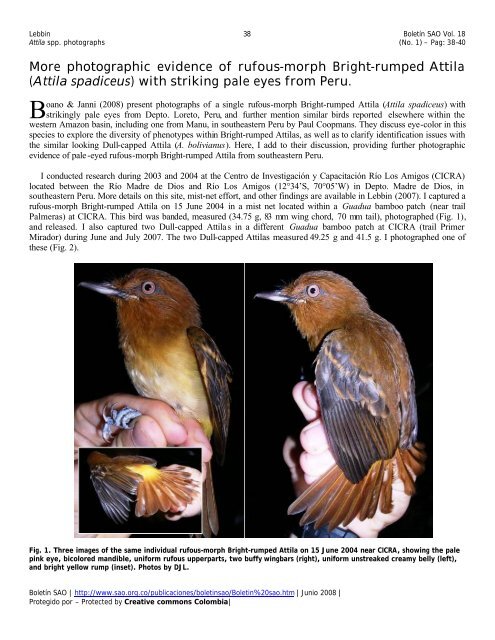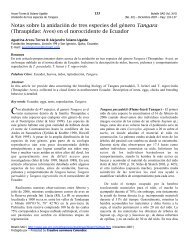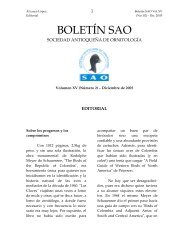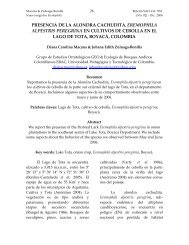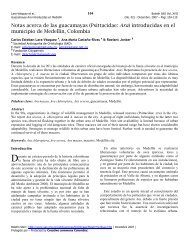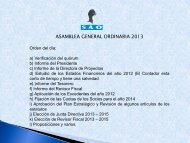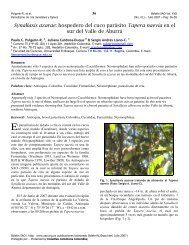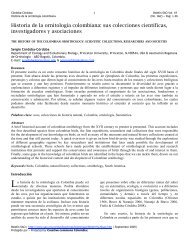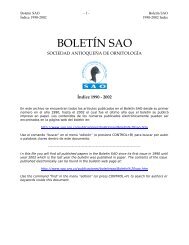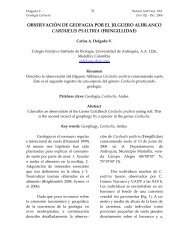More photographic evidence of rufous-morph Bright-rumped Attila ...
More photographic evidence of rufous-morph Bright-rumped Attila ...
More photographic evidence of rufous-morph Bright-rumped Attila ...
Create successful ePaper yourself
Turn your PDF publications into a flip-book with our unique Google optimized e-Paper software.
Lebbin 38 Boletín SAO Vol. 18<br />
<strong>Attila</strong> spp. photographs (No. 1) – Pag: 38-40<br />
<strong>More</strong> <strong>photographic</strong> <strong>evidence</strong> <strong>of</strong> <strong>rufous</strong>-<strong>morph</strong> <strong>Bright</strong>-<strong>rumped</strong> <strong>Attila</strong><br />
(<strong>Attila</strong> spadiceus) with striking pale eyes from Peru.<br />
B<br />
oano & Janni (2008) present photographs <strong>of</strong> a single <strong>rufous</strong>-<strong>morph</strong> <strong>Bright</strong>-<strong>rumped</strong> <strong>Attila</strong> (<strong>Attila</strong> spadiceus) with<br />
strikingly pale eyes from Depto. Loreto, Peru, and further mention similar birds reported elsewhere within the<br />
western Amazon basin, including one from Manu, in southeastern Peru by Paul Coopmans. They discuss eye-color in this<br />
species to explore the diversity <strong>of</strong> phenotypes within <strong>Bright</strong>-<strong>rumped</strong> <strong>Attila</strong>s, as well as to clarify identification issues with<br />
the similar looking Dull-capped <strong>Attila</strong> (A. bolivianus). Here, I add to their discussion, providing further <strong>photographic</strong><br />
<strong>evidence</strong> <strong>of</strong> pale-eyed <strong>rufous</strong>-<strong>morph</strong> <strong>Bright</strong>-<strong>rumped</strong> <strong>Attila</strong> from southeastern Peru.<br />
I conducted research during 2003 and 2004 at the Centro de Investigación y Capacitación Río Los Amigos (CICRA)<br />
located between the Río Madre de Dios and Río Los Amigos (12°34’S, 70°05’W) in Depto. Madre de Dios, in<br />
southeastern Peru. <strong>More</strong> details on this site, mist-net effort, and other findings are available in Lebbin (2007). I captured a<br />
<strong>rufous</strong>-<strong>morph</strong> <strong>Bright</strong>-<strong>rumped</strong> <strong>Attila</strong> on 15 June 2004 in a mist net located within a Guadua bamboo patch (near trail<br />
Palmeras) at CICRA. This bird was banded, measured (34.75 g, 83 mm wing chord, 70 mm tail), photographed (Fig. 1),<br />
and released. I also captured two Dull-capped <strong>Attila</strong>s in a different Guadua bamboo patch at CICRA (trail Primer<br />
Mirador) during June and July 2007. The two Dull-capped <strong>Attila</strong>s measured 49.25 g and 41.5 g. I photographed one <strong>of</strong><br />
these (Fig. 2).<br />
Fig. 1. Three images <strong>of</strong> the same individual <strong>rufous</strong>-<strong>morph</strong> <strong>Bright</strong>-<strong>rumped</strong> <strong>Attila</strong> on 15 June 2004 near CICRA, showing the pale<br />
pink eye, bicolored mandible, uniform <strong>rufous</strong> upperparts, two buffy wingbars (right), uniform unstreaked creamy belly (left),<br />
and bright yellow rump (inset). Photos by DJL.<br />
Boletín SAO | http://www.sao.org.co/publicaciones/boletinsao/Boletin%20sao.htm | Junio 2008 |<br />
Protegido por – Protected by Creative commons Colombia|
Lebbin 39 Boletín SAO Vol. 18<br />
<strong>Attila</strong> spp. photographs (No. 1) – Pag: 38-40<br />
The <strong>rufous</strong>-<strong>morph</strong> <strong>Bright</strong>-<strong>rumped</strong> <strong>Attila</strong> was identified in the field based on plumage coloration that distinguish this<br />
species from the similar Dull-capped <strong>Attila</strong>, including the bright yellow rump contrasting with <strong>rufous</strong> back and tail, and<br />
presence <strong>of</strong> two wing bars. The wing chord <strong>of</strong> this <strong>Bright</strong>-<strong>rumped</strong> <strong>Attila</strong> (83 mm) was very similar to that reported (80<br />
mm) by Boano & Janni (2008). Its mass was less than that <strong>of</strong> the two Dull-capped <strong>Attila</strong>s captured at CICRA, and two<br />
more I captured on 17 October 2004 (46.5 g and 53.5 g each) along the Río Tahuamanu (11°23’S, 69°32’W) in<br />
southeastern Peru. The <strong>Bright</strong>-<strong>rumped</strong> <strong>Attila</strong> at CICRA had strikingly pale pink eyes (Fig. 1), different from the pale<br />
whitish eyes in Boano & Janni’s (2008) photographs; however, both lacked streaks on their underparts.<br />
The photographs published here add to those <strong>of</strong> Boano & Janni (2008) to increase the <strong>evidence</strong> <strong>of</strong> <strong>rufous</strong>-<strong>morph</strong><br />
<strong>Bright</strong>-<strong>rumped</strong> <strong>Attila</strong>s with strikingly pale eyes, as well as expand known variation in eye color (pale pink) among such<br />
pale-eyed individuals.<br />
Fig. 2. A Dull-capped <strong>Attila</strong> captured in 2003 at CICRA. Note the more uniform colored bill, dull gray crown feathers,<br />
contrasting paler chin, and lack <strong>of</strong> buffy wingbars compared to the <strong>Bright</strong>-<strong>rumped</strong> <strong>Attila</strong> in Fig. 1. Photo by DJL.<br />
Acknowledgements<br />
Boletín SAO | http://www.sao.org.co/publicaciones/boletinsao/Boletin%20sao.htm | Junio 2008 |<br />
Protegido por – Protected by Creative commons Colombia|
Lebbin 40 Boletín SAO Vol. 18<br />
<strong>Attila</strong> spp. photographs (No. 1) – Pag: 38-40<br />
I am grateful to El Instituto Nacional de Recursos Naturales (INRENA) for permission to conduct research in Peru, as<br />
well as to the Boletín SAO editorial team and Ottavio Janni for their rapid comments on these photos.<br />
Literature Cited<br />
Boano, G. & O. Janni. 2008. Rufous-<strong>morph</strong> <strong>Bright</strong>-<strong>rumped</strong> <strong>Attila</strong> (<strong>Attila</strong> spadiceus) with white eyes: <strong>photographic</strong><br />
<strong>evidence</strong> from Peru. Boletín SAO 18(1): 16-19.<br />
Lebbin, D. J. 2007. Habitat specialization among Amazonian birds: Why are there so many Guadua bamboo specialists?<br />
Ph.D. dissertation. Cornell University, Ithaca, New York.<br />
Daniel J. Lebbin<br />
Department <strong>of</strong> Ecology and Evolutionary Biology, Cornell Laboratory <strong>of</strong> Ornithology, Cornell University, Ithaca, NY<br />
14850, USA.<br />
E-mail: djl42@cornell.edu<br />
Boletín SAO | http://www.sao.org.co/publicaciones/boletinsao/Boletin%20sao.htm | Junio 2008 |<br />
Protegido por – Protected by Creative commons Colombia|


